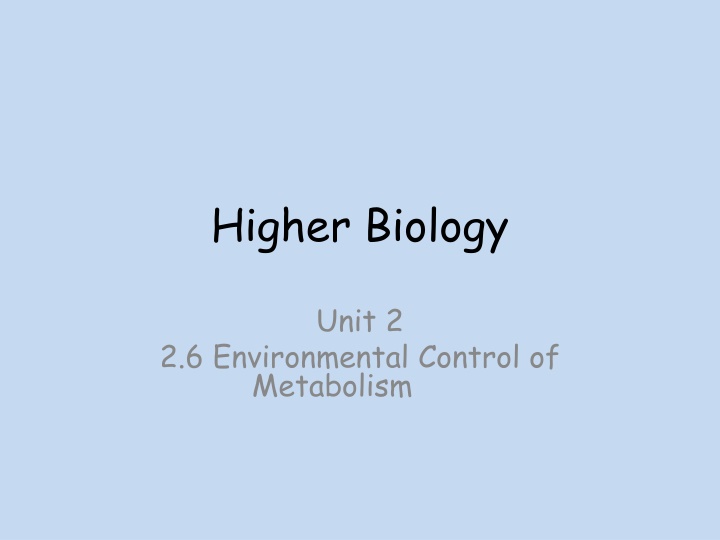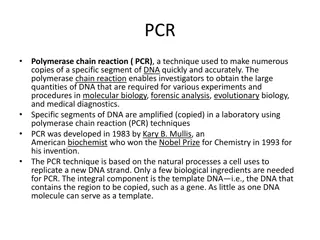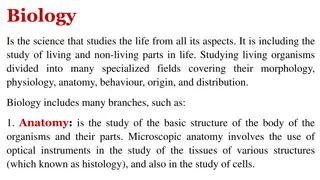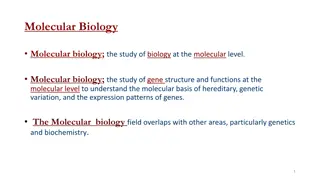Higher Biology
Microorganisms, including microbes, play essential roles in various industries due to their rapid reproduction and easily controlled metabolism. This article explores the significance of microorganisms in biotechnology and the different growth stages of microbes. It also delves into the role of primary metabolism during lag and log phases, highlighting the processes involved in environmental control of microbial activities.
Download Presentation

Please find below an Image/Link to download the presentation.
The content on the website is provided AS IS for your information and personal use only. It may not be sold, licensed, or shared on other websites without obtaining consent from the author.If you encounter any issues during the download, it is possible that the publisher has removed the file from their server.
You are allowed to download the files provided on this website for personal or commercial use, subject to the condition that they are used lawfully. All files are the property of their respective owners.
The content on the website is provided AS IS for your information and personal use only. It may not be sold, licensed, or shared on other websites without obtaining consent from the author.
E N D
Presentation Transcript
Higher Biology Unit 2 2.6 Environmental Control of Metabolism
Microorganisms Microbes are tiny living things that can only be seen with a microscope. Most microbes do not affect humans. However, a small number can be harmful and there are many that are useful. It is these useful microbes that are so important in industry.
Microorganisms Microbes are found in all three domains of life; Eukaryotes Bacteria Archaea Microorganisms Eukaryotes Prokaryotes Bacteria Archaea
Microorganisms Using microbes in industry to make useful products, is often called biotechnology. Microbes are used in industry because; they reproduce rapidly Their metabolism can be easily controlled
Stage 1 Lag Phase Little (or no) increase in the number of cells. Microbes adjust to the growth medium.
Stage 2 Log Phase Cells grow and multiply at a maximum rate. Microbes have ideal conditions for growth.
Stage 3 Stationary Phase No net increase in the number of cells. The rate of production of new cells is equal to the death rate of old cells.
Stage 4 Death Phase The death rate of old cells is greater than the rate of production of new cells. Concentration of respiratory substrate decreases and concentration of toxins (waste products) increases.
Log Graphs Log graphs are used to show the growth of microbes during the log stage. On log graphs, intervals on the y- axis increase from 1-10, then from 10-100 and so on.
Log Graph Question How many cells survive after 6 minutes? A. 1300 B. 4000 C. 5000 D. 5500
Primary Metabolism Occurs during the lag and log phases Microbes break down substrates to release energy Primary metabolites are produced by microbes These are used for growth e.g. amino acids
Secondary Metabolism Occurs at the end of the log phase and during the stationary phase Secondary metabolites are produced by microbes These are not used for growth
Secondary Metabolites Can be toxic to some microbes. Can confer an ecological advantage to the microbe e.g. antibiotics produced by fungi inhibit growth of bacteria, thus reducing competition. Many have properties that are useful to humans e.g. ethanol. Microbes used in industry are often required to over produce this metabolite.
Controlling Metabolism The metabolic pathways of microbes can be regulated by controlling the action of enzymes. This is done through; Enzyme induction Enzyme inhibition
Controlling Metabolism In this pathway metabolite C is the desired product. Metabolite A is a precursor. It will be acted upon by the first enzyme in the pathway to produce metabolite B.
Controlling Metabolism Metabolite B is an inducer. A constant supply of metabolite B ensures that enzyme 2 remains active, converting B into C.
Controlling Metabolism An inhibitor must be used to prevent enzyme 3 converting metabolite C into metabolite D. This ensures mass production of the desired product metabolite C.


![❤[READ]❤ Cosmic Biology: How Life Could Evolve on Other Worlds (Springer Praxis](/thumb/21556/read-cosmic-biology-how-life-could-evolve-on-other-worlds-springer-praxis.jpg)




















